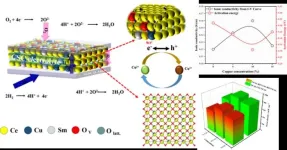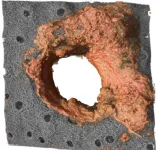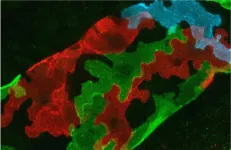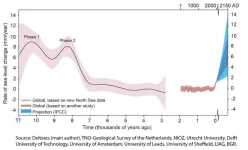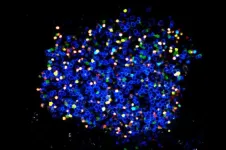A joint research team from Southeast University and Shenzhen University has developed a novel function of semiconductor-ionic conductor (SIC) using a Cu-Sm co-doping ceria (SCDC). By enhancing ionic and electronic conductivity in the same time, the team is able to achieve superionic transport property and excellent fuel cell performance using the SIC electrolyte. It changes traditional pure ionic electrolyte to SIC with strong electron-ion coupling synergistic effect to obtain exceptional ionic conductivity and fuel cell performance. This study leads to a new way to develop advanced electrolytes and fuel cells in energy conversion technologies.
Ceramic fuel cells are a type of solid oxide fuel cell (SOFC) that use a ceramic electrolyte to convert chemical energy from fuel (like hydrogen or natural gas) directly into electrical energy through an electrochemical reaction. Electrolytes are the core functional component of it, dictating ion transport efficiency, charge transfer kinetics, and overall cell performance. A group of researchers led by Prof. Bin Zhu has challenged the fundamental limitations in ionic conductivity, charge transport, and long-term operational stability. They showed that a co-doping of ceria (CeO2) with Samarium (Sm3+) and Copper (Cu2+), Cu0.1Sm0.1CeO2, can enhance the ionic conductivity and electronic conduction. It can reach an exceptional ionic conductivity of 0.16 S/cm at 520 °C, which is higher than conventional materials that cannot even reach 0.1 S/cm at 800 °C. This fuel cell performance boost with excellent power output, 902 mW/cm2 at 520 °C and long-term operational stability is attributed to electron-ion (E-I) coupling, in which Sm3+ actively participates in charge modulation, fine-tuning defect interactions and optimizing charge carrier redistribution. While Cu2+ introduces redox-active electronic pathways, dynamically regulating charge transfer and enhancing optimized conduction efficiency.
E-I Coupling and Microstructural Refinement
The main problem with traditional doping methods, like Sm3+ doping CeO2 (SDC), was that they did not allow enough ionic conductivity. Co-doping Sm3+ and Cu2+, on the other hand, does not just add oxygen vacancies; it also creates a completely new way for charges to move.
Sm3+ and Cu2+ actively drive electron-ion coupling, orchestrating defect interactions and optimizing charge carrier mobility. Cu2+/Cu+ serves as a redox-active mediator, creating a dynamic electron reservoir that stabilizes charge transfer. The synergy between defect chemistry and microstructural refinement establishes highly efficient mixed conduction pathways, unlocking superior charge transport and fuel cell performance.
Beyond chemical modifications, the real rule-changer lies in structural refinement. The co-doped electrolyte features a denser grain network with smaller, well-distributed boundaries, drastically improving ion mobility. These microstructural enhancements also support strong phase stability, redox flexibility, and long-term durability, ensuring sustained performance over an extended period. The increased grain boundary density and tailored lattice distortions play a crucial role in enabling faster charge transfer, reduced resistance, and superior fuel cell efficiency.
Impact:
This work represents a significant advancement in electrolyte materials for low-temperature solid oxide fuel cells (LT-SOFCs) by demonstrating that co-doping in Cu₀.₁Sm₀.₁CeO₂ enhances charge transfer kinetics, enabling rapid ion and proton mobility through electron-assisted transfer. The electron ion (E-I) coupling mechanism establishes a low-activation-energy conduction pathway, optimizing energy efficiency. The detailed clarification of the E–I coupling mechanism provides valuable scientific insight into charge modulation and defect interactions, paving the way for innovative material functions and filling critical knowledge gaps in electrochemical device design and manufacturing. Microstructural improvements, including a denser grain network and precisely tuned lattice distortions, significantly enhance ion conductivity and ensure long-term operational stability—key factors for achieving high-efficiency, commercially competitive low-temperature ceramic fuel cells. This breakthrough delivers exceptional performance, efficiency, and durability, positioning LT-SOFCs for broad impact across various energy applications.
Scaling Up Ceramic Fuel Cells: Unmatched Performance, Efficiency, and Industrial Potential
The Sm-Cu co-doped ceria (SCDC) electrolyte represents a major leap toward commercially scalable ceramic fuel cells. By leveraging E-I coupling to enhance mixed conduction, it optimizes charge transfer pathways, significantly reducing operating temperatures and manufacturing costs while ensuring long-term stability. The SCDC electrolyte’s ability to achieve a remarkable power density of 902 mW/cm2 at 520 °C, coupled with stable operational durations, marks a significant leap toward scalable and commercially viable ceramic fuel cells. This advancement sets a new benchmark for high-performance ceramic fuel cells, leading the way for widespread adoption in next-generation energy solutions. Its versatility makes it ideal for hydrogen-powered vehicles, improving fuel cell efficiency in electric vehicles (FCEVs); portable power systems, and hydrogen production for renewable energy storage with clean energy solutions for industrial applications;
The research has been recently published in the online edition of Materials Futures, a prominent international journal in the field of interdisciplinary materials science research.
Reference: Muhammad Shahid Sharif, Zuhra Tayyab, Sajid Rauf, Muhammad Ahsan Masood, MAK Yousaf Shah, Muhammad Tayyab, Abdullah N. Alodhayb, Bin Zhu. Redefining Electrolyte Efficiency: Bridging the Gap with a Systematic Samarium-Copper Co-Doping Approach for Optimized Conductivity in Advanced Semiconductor Ionic Fuel Cell[J]. Materials Futures. DOI: 10.1088/2752-5724/adbcc9
END
